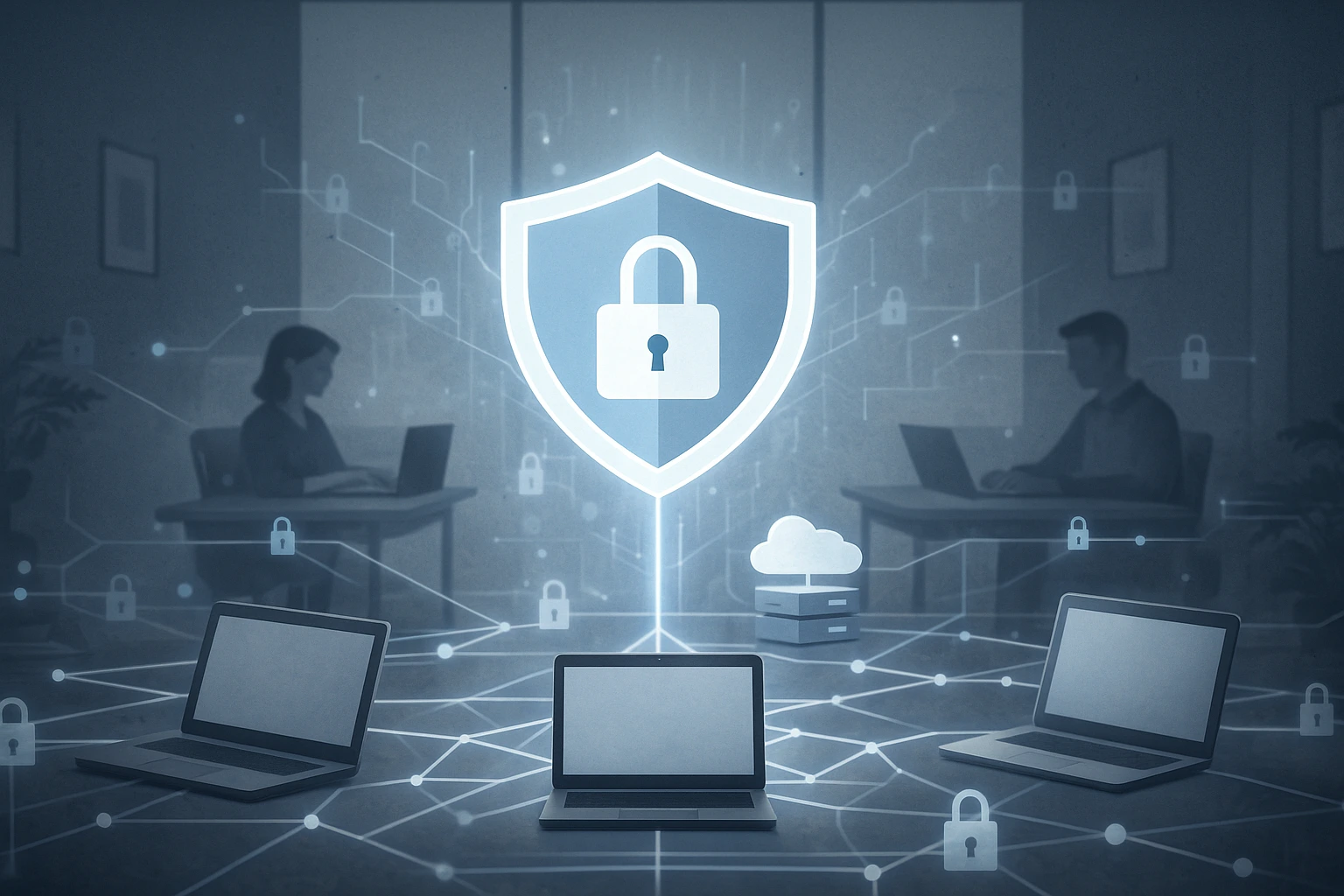Cybersecurity and Data Protection for Smaller Service Organisations
By Brendan Byrne - CEO Tuesday, November 18, 2025

Cybersecurity and Data Protection for Smaller Service Organisations

In today’s digital-first environment, even the smallest service organisation handles valuable data—customer records, payment information, internal documents, and sometimes sensitive personal details. Many business owners assume cyber-criminals only target large corporations. In reality, smaller service organisations are increasingly becoming prime targets because attackers know that most small businesses have weaker security controls, limited technical resources, and fewer staff dedicated to monitoring digital risks.
Cybersecurity for small businesses is no longer optional—it is foundational to long-term survival, operational continuity, and customer trust. The good news? You don’t need a large IT department or expensive enterprise tools to significantly strengthen your defences. With the right approach, even small teams can create a strong digital security framework that protects their data, reduces vulnerabilities, and demonstrates professionalism to clients.
This guide breaks down the essential areas every small service organisation should focus on to build a strong cybersecurity posture while maintaining operational efficiency.
Why Small Service Organisations Are Being Targeted More Often
There are three main reasons small organisations are now on the radar of cybercriminals:
1. Smaller businesses often underestimate cyber risks
Many small business owners believe “we’re too small to hack” or assume attackers only pursue financial institutions and large tech companies. But automated attacks now scan the internet continuously for vulnerable systems, unsecured Wi-Fi networks, outdated software, and weak passwords. Size no longer matters.
2. Lower security budgets
Most smaller organisations have limited budgets for IT security and rarely invest in specialised tools or staff. Hackers know this and exploit it.
3. Valuable customer data
Even a small organisation manages data that can be monetised: names, emails, addresses, payment details, and client histories. This information can be sold or used for identity theft, phishing scams, or further attacks.
In short: low defences + valuable data = attractive target.
The Cost of a Cyber Attack on a Small Organisation
A cyber-attack is not just an inconvenience—it’s potentially devastating. Common consequences include:
- Financial loss from fraudulent transactions, ransom payments, or system recovery.
- Downtime, which for small organisations means missed appointments, cancelled services, or loss of productivity.
- Data loss, especially if there are no secure backups.
- Legal or compliance issues, depending on your industry and location.
- Permanent loss of customer trust, which often costs more than the attack itself.
A single breach can set back a small business for months—or permanently close its doors.
Essential Cybersecurity Foundations for Small Service Organisations
You don’t need enterprise-level infrastructure to protect your organisation. Instead, focus on building strong foundational practices.
1. Strengthen Password Policies and Use Multi-Factor Authentication (MFA)
Using simple passwords or repeating the same password across multiple platforms is one of the biggest risks for small organisations.
What to do:
- Require strong passwords for every account.
- Ensure staff never reuse passwords.
- Introduce a password manager to simplify secure storage.
- Enable MFA everywhere possible—email, CRM, scheduling tools, and internal systems.
MFA prevents 99% of account takeover attempts, making it one of the cheapest and most effective protections available.
2. Keep All Software and Devices Updated
Outdated systems are one of the most common entry points for cyber-attacks. Developers regularly release security patches that address vulnerabilities. If updates are ignored, you leave the door open.
Set a strict update routine:
- Enable auto-updates on laptops, tablets, and phones.
- Keep your CRM, website CMS, scheduling apps, and payment systems updated.
- Remove old or unused programs that may be vulnerable.
Even a small update can close a major security gap.
3. Protect Your Wi-Fi Network and Hardware
Small service organisations often operate in shared spaces or use simple routers provided by internet service providers. These default setups are usually insecure.
Steps to secure your network:
- Change the default router password immediately.
- Use WPA3 or WPA2 encryption.
- Hide or rename your network to something neutral (never include your business name).
- Maintain a separate guest network if clients need Wi-Fi access.
- Make sure all company devices use up-to-date antivirus or endpoint protection.
The goal is to prevent outsiders from accessing your internal systems.
4. Implement a Strong Backup System
Backups are essential for recovery after ransomware attacks, accidental deletion, or device failure.
Your backups should be:
- Automated (so nothing is forgotten)
- Stored in multiple locations, ideally including a cloud service
- Regularly tested to ensure they can be restored
This is one of the simplest safeguards against catastrophic data loss.
5. Train Your Team on Cyber Awareness
Human error remains the biggest cause of data breaches. Clicking on phishing links, opening suspicious attachments, or sharing passwords accidentally can expose your entire system.
Provide simple, ongoing training on:
- How to identify phishing emails
- Safe browsing habits
- How to report suspicious activity
- Best practices for handling customer data
Even small improvements in team awareness can reduce your cyber risk dramatically.
6. Limit Access and Permissions
Not every employee needs access to all systems. Restrict data access based on role, and ensure former staff members are removed from all platforms immediately.
Principle of Least Privilege:
Employees should only have the access they need to perform their duties—nothing more.
This helps prevent both accidental and intentional misuse.
7. Use Encrypted Communication and Secure File Sharing
Whether you send invoices, contracts, or customer records, ensure that you are using secure platforms.
Avoid sending sensitive information through:
- Regular email without encryption
- Public file-sharing links
- Personal messaging apps
Instead, use secure client portals, encrypted email add-ons, or reputable cloud-sharing tools that offer access control.
8. Document Your Cybersecurity Policies
Even small organisations benefit from a simple policy document that outlines:
- Acceptable device use
- Password rules
- Backup procedures
- Remote work guidelines
- Data handling workflows
This ensures consistency and accountability across your team. A documented policy also demonstrates professionalism to clients and partners.
9. Use Tools Designed for Small Organisations
Many digital security tools are built specifically for small teams with limited budgets. These include:
- Affordable endpoint security software
- Cloud backup services
- Password managers
- Simple firewalls
- Secure scheduling and CRM tools
You can explore relevant tools internally here: See our cybersecurity resources.
Modern tools are now more accessible, automated, and beginner-friendly than ever.
Final Thoughts: Small Steps Create Big Protection
Cybersecurity doesn’t have to be complicated. For smaller service organisations, the goal is not to create military-grade systems—it’s to build a strong, practical foundation that protects your data, your operations, and the trust your clients place in you.
By focusing on password hygiene, software updates, secure networks, staff education, and reliable backups, your organisation becomes far harder to target—and far quicker to recover, should something go wrong.
Security is not a one-time setup; it’s an ongoing commitment. But with the right processes, even the smallest organisation can achieve enterprise-level protection without enterprise-level cost.


